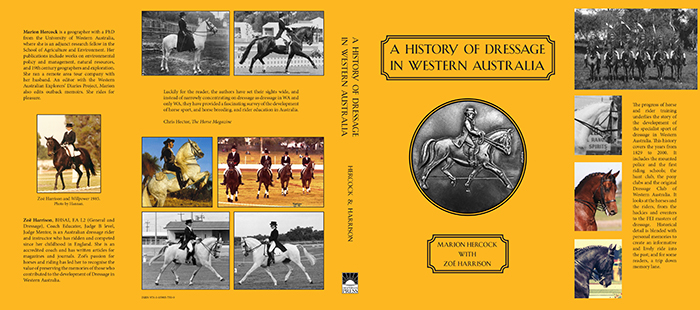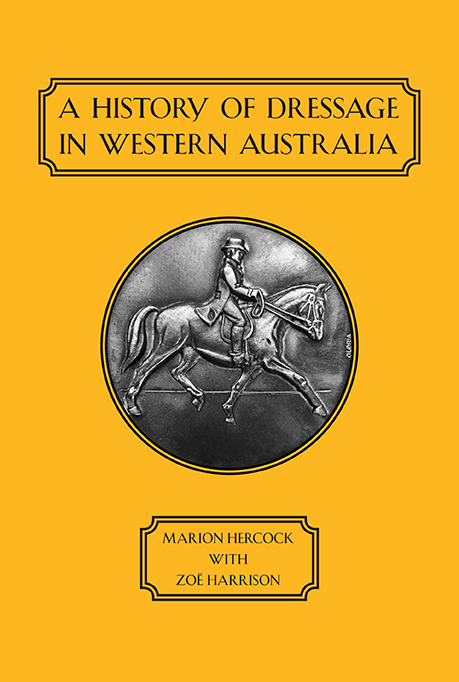
Reviewed by Christopher Hector
A history of dressage in Western Australia… my first thought, somewhat unkindly, was that it was the equivalent of a history of leg spin bowling in Lower Saxony, but I am a history tragic, I just love reading history and I welcomed the offer from the authors, Marion Hercock and Zoë Harrison, to send me an advance copy. I’m glad I did.
Luckily for the reader, the authors have set their sights wide, and instead of narrowly concentrating on dressage as dressage in WA and only WA, they have provided a fascinating survey of the development of horse sport, and horse breeding, and rider education in Australia.
Lest you think that the dressage clinic as entertainment was invented by Anky and Kyra, and refined by Carl and Charlotte, think again, in the nineteenth century ‘horse tamers’ regularly toured theatres and halls all over Australia combining the diffusion of equestrian knowledge and a nice night out.
” For example, in 1865 in Melbourne, the visiting American horseman G.A. Belew republished his illustrated book The Horseman’s Complete Guide: Containing an original theory of taming, training and educating the horse. Styled ‘Professor’, Belew had toured the Eastern States in 1864 and 1865 giving lectures and demonstrations of breaking and handling.One reviewer of Belew’s show emphasised the difference between Belew’s gentleness and firmness in contrast to the methods of fellow American John Solomon Rarey.”
Rarey was another who toured the theatres demonstrating his method that mainly seemed to involve tying up the horse’s limbs and throwing it to the ground. At least into the 80’s the R. M. Williams catalogue advertised ‘Rarey Straps’.
It amuses me to hear people say ‘oh that is just circus’ – for much of the nineteenth century, circus kept alive High School work, indeed Baucher’s public career came to an end when a chandelier fell on him in a circus ring. It was much the same in Western Australia:
“The prosperity and population generated by the Western Australian gold rushes made the state a more attractive market for enterprising entertainers, especially the circus. Horse based entertainment in the circus played a part in spreading the art of equitation and the idea of educating horses to a high degree. Showmen and women, horse trainers, trick riders, bareback riders, bull riders and other circus performers with their buckjumpers, high jumpers and dancing horses made their way to Western Australia. These colourful characters included Mademoiselle Louise of Wirth Brothers Circus, James Byron Hayes, Michael Fenton and his wife; and later the Hyland (Roberts) family, who were prominent in the early 20th century.”
“The Fentons made a mark in Western Australian equitation in the short time they were in the State. They are of some interest because they showed Western Australians that trained horses could perform better and achieve more in the show ring than untrained horses. The couple educated and sold horses, performed in the circus and also competed in the agricultural shows with a high degree of success. In 1889* Michael Fenton had promoted himself as a horse tamer ‘professor’ in country South Australia before joining Wirth Brothers Circus.Fenton had started with Professor Hyland (John Roberts) and later, in his own horse taming act he appeared to ‘utterly ignore all the old-fashioned harsh methods of colt breaking.’ In mid-1883 Mr and Mrs Fenton accompanied by a child came to Western Australia with the Wirths.”
“At their circus in Perth in July 1893, and later in Fremantle, the Fentons were part of the cowboy acts or ‘Wild West episodes’. These displays ‘concluded with an exhibition of buckjumping, which showed very creditable riding on the part of Mrs Fenton, the lady buckjump rider…”
“When the Wirths returned to Adelaide for departure overseas, the Fentons stayed in Western Australia. In addition to establishing their own circus and horse education business, Michael and Mrs Fenton competed in and usually won the ridden events for hacks, hunters and jumpers at the agricultural shows. At her first outing at the Royal Agricultural Show at Guildford in 1893 Mrs Fenton was unplaced among nine ‘fair equestriennes’ in the Lady’s Hack class. However, she rode the grey Warrigal over jumps in the Hunters class to win and she also won the special prize for ‘leaping over four foot’. Over the next five years her husband also competed at the Royal Shows and country shows including the Wellington Agricultural Society’s annual show at Bunbury.The success of the Fentons in the show ring was almost certainly due to the training they gave their horses. Indeed, in the 20th century, it would be the show hack riders who had learnt the value of training, who would take up dressage.”
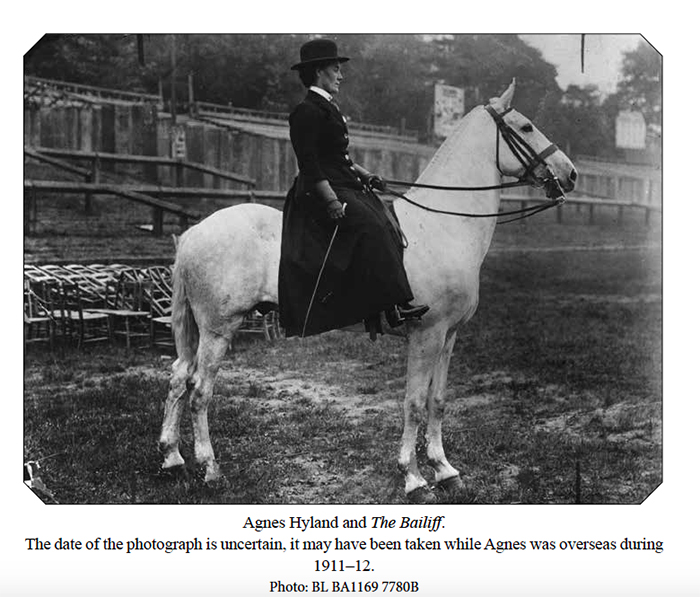
It seems that it was Agnes, the daughter of self-styled Professor D’Arcy Hyland (John Thomas Roberts), who was the first from the West to make it to Germany to study, and she put the experience to work in the circus ring:
‘I trained all the horses in the circus in high school work – that is to say, the high stepping, the marching, and the many tricks that most horses are capable of.’
It’s worth mentioning that the first Western Australian representative to almost make it into an Australian team was the Spanish emigré to WA, Jose Mendez who had been imported to work the dancing white horses at El Caballo Blanco. In mid-1985, Jose was named the only WA representative on the National Dressage Squad, with the first cross Andalusian, El Caballo Cadiz – and in yet another nod to tradition, his older brother, Manolo, is now styled Professor Manolo Mendez…
By 1949, Australian riders had a new opportunity on the horizon, the 1956 Olympic Games. One who offered to prepare our riders for the Games, was Dutch coach Berend van Eerten, he calculated he could bring horses up to standard in just 20 lessons. Here are his comments in the Adelaide Mail:
He believed that: without training in advanced European methods of handling horses in the showring, Australians will be at a serious disadvantage in horse events at the Olympic Games in Melbourne in 1956…. His method of teaching, called dressage, is new to Australia. … dressage was the science of teaching a horse to obey its rider, to be supple and obedient, to obey the rider over jumps either right handed or left handed, and to carry out difficult manoeuvres such as figures-of eights in the showring. It was simply a higher education for a showhorse…”
“He said an experienced rider could learn dressage fully in 20 lessons. The horse also had to be trained. Best age to train a horse was five, as it was then old enough to understand fully what it was being taught, and also old enough to stand up to the severe training.”
“Australian riders have all the requirements of good horsemanship for the Olympic Games except the final polish. I hope to be able to give them this,” said the Dutchman. In truth, while we were represented in eventing and showjumping at the 1956 Games, it would be Los Angeles in 1984 before Margaret McIvor and CK would be the first Aussies to ride down the centre line at a Games.
Dressage in WA received a boost in March 1950 when Kalman de Jurenak and his wife Walburg arrived in Western Australia having been transferred from the Bagnoli Displaced Persons Camp in Italy as part of the International Refugee Organization Group Resettlement to Australia.
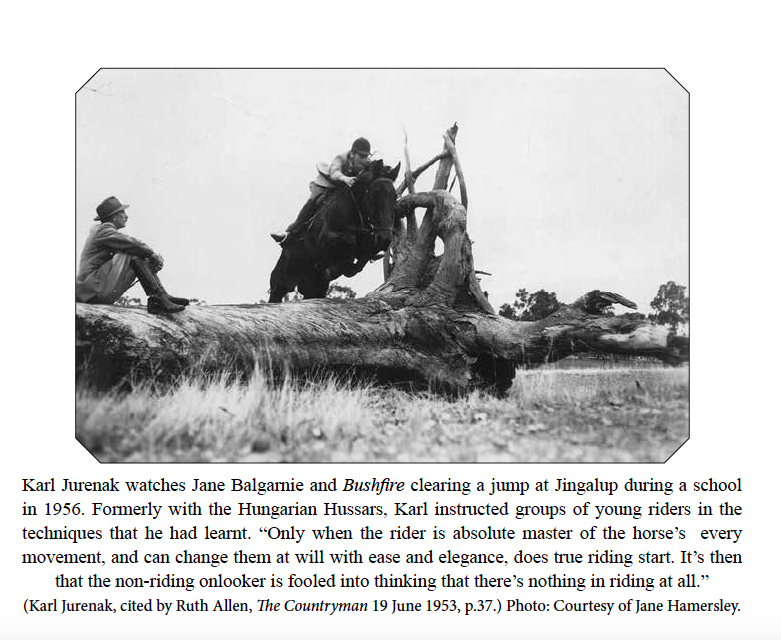
“Born in 1924, Karl Jurenak had been brought up on ‘absolutely classical’ riding, and during World War II served as a Hussar. He said that owing to very lucky circumstances in the war he had escaped from Hungary when the communists arrived. From Hungary he went to work with Otto Lörke in Germany where ‘I got a little bit of a foundation (in classical riding) and I believed in that discipline.'”
Kalman moved to the East to work with Franz Mairinger in 1958, traveling on to New Zealand before he took up a position with the Hanoverian Verband in Verden, Germany, where his skill as a horse trainer combined with his abundance of suave Hungarian charm made him greatly prized – particularly when it came to dealing with rich ladies in search of their next horse…
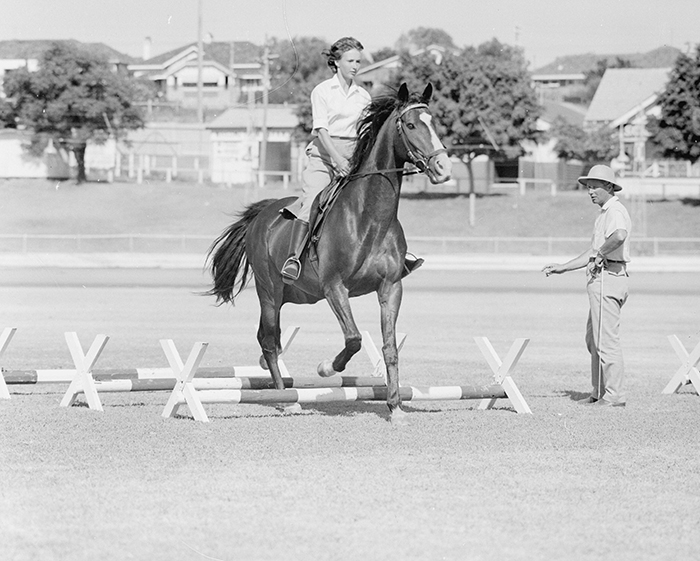
I hope by now I have whetted your appetite, and you realise that this labour of love from Marion Hercock and Zoë Harrison, is a fascinating read. I won’t give the end away, for the formation of the EFA and lots lots more, you need your own copy.
A History of Dressage in Western Australia is illustrated and fully indexed.
ISBN 978-0-85905-750-9, published by Hesperian Press, http://www.hesperianpress.com
